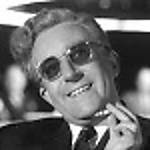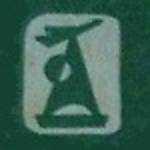Hi Torsten!
I don't know how your excellent Ki-61 got past me. Thank you for telling us about the pilot. So little is known about Japanese pilots that I feel glad every time I learn about one.
Thank you for the history, and thank you for sharing your excellent build with us.
Gaz
World War II
Discuss WWII and the era directly before and after the war from 1935-1949.
Discuss WWII and the era directly before and after the war from 1935-1949.
Hosted by Rowan Baylis
What lately left my assembly line
Posted: Tuesday, December 06, 2016 - 02:46 PM UTC

BlackWidow

Joined: August 09, 2009
KitMaker: 1,732 posts
AeroScale: 1,336 posts

Posted: Tuesday, December 06, 2016 - 09:24 PM UTC
Quoted Text
.... Don't know how you managed to live without the internet for 2 weeks.
Joel
That is so easy, Joel, you won't believe it. I have 2 great hobbies, were you don't really need the internet - building model kits and travelling. My Transportpanzer (APC) "Fuchs" made a big step towards the finish line in the last 2 weeks .... And for the days around New Years Eve I'll be in the swedish capital where I don't need the www again for some time.
Stefan, thanks for your nice comment. Glad you like my latest build.
Gary, also thanks for your feedback. You're right, it's not easy to find informations about japanese pilots, especially when their names are not Sakai, Iwamoto or Kashiide - just to name some well known pilots. All my informations in case of Itagaki I've got from my Osprey books. The internet has only very little information if any. Recently I had the chance to have a glimpse into a japanese language book about all the Bukosho recipents. Though I couldn't read it at all, their names were also written in Latin letters and I found this photo of Masao Itagaki without oxygen mask ....
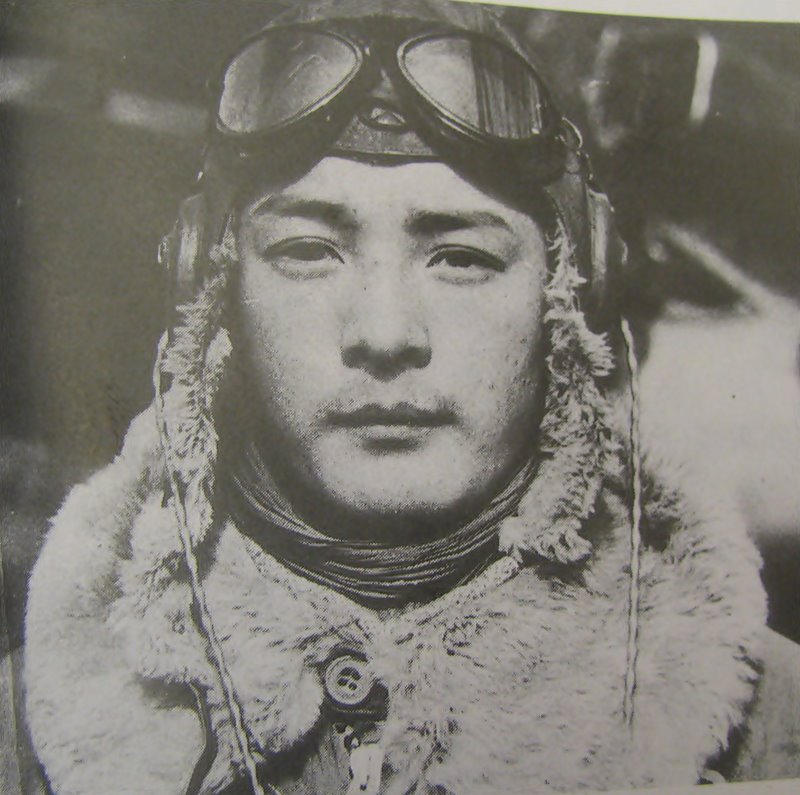

BlackWidow

Joined: August 09, 2009
KitMaker: 1,732 posts
AeroScale: 1,336 posts

Posted: Saturday, March 11, 2017 - 09:59 PM UTC
Last weekend I have finished my - so far - only 2017 campaign and today I had time to take photos of my "Soviet Phoenix". Here is the latest addition to my aviation museum, the Petlyakov Pe-2 from Zvezda in 1/48 .... 
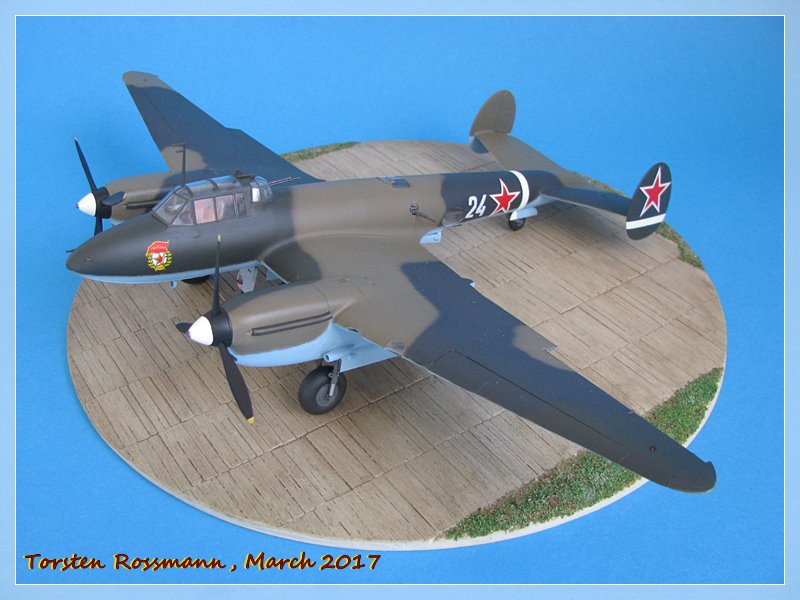


.... the Pe-2 was the most numerous soviet twin-engined bomber of WW2. Vladimir Petlyakov designed it as a high altitude fighter under the designation VI-100 when he was imprisoned from 1937 on. The first prototype flew in December 1939. Just as mass production was ready to begin, the VVS ordered a re-design of the aircraft to a tactical bomber. Within 45 days Petlyakov redesigned the aircraft and the result was so good that Stalin ordered to set Petlyakov free again. From that time the aircraft was called Pe-2. Though the flying characteristics were great once the Pe-2 was in the air, the aircraft demanded high flying skills of the pilot during take off and especially during landing because of the high landing speed. The bomber could also not fly on one engine without loosing altitude. Nevertheless more than 10.500 (some sources say 11.500) Pe-2 had been built when production ended in August 1945. The "Peshka", as it was called by its crews, was used as a medium bomber, dive bomer, for ground attack and reconnaissance. It equipped more than 80 bomber regiments. The aircraft with a crew of 3 had a maximum speed of 580 km/h, a range of about 1200 kilometers and a service ceiling of 8800 meters. It was powered by 2 liquid cooled Klimov M-105 engines with 1210 hp each. The armament consited of 2 in the nose fixed ShKAS machine guns and 3 rearward firing machine guns caliber 7,62 mm. It could carry up to 1600 kg of bombs. During the war Finland used 7 captured Pe-2. Post war users were Bulgaria, China, Czechoslovakia, Hungary, Poland and Yugoslavia. There are a few "Peshkas" left in museums around Europe ....
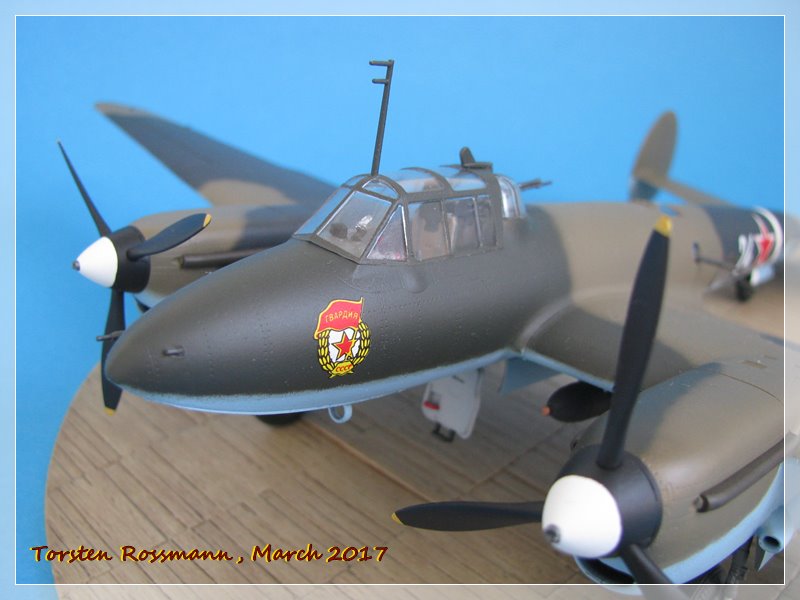
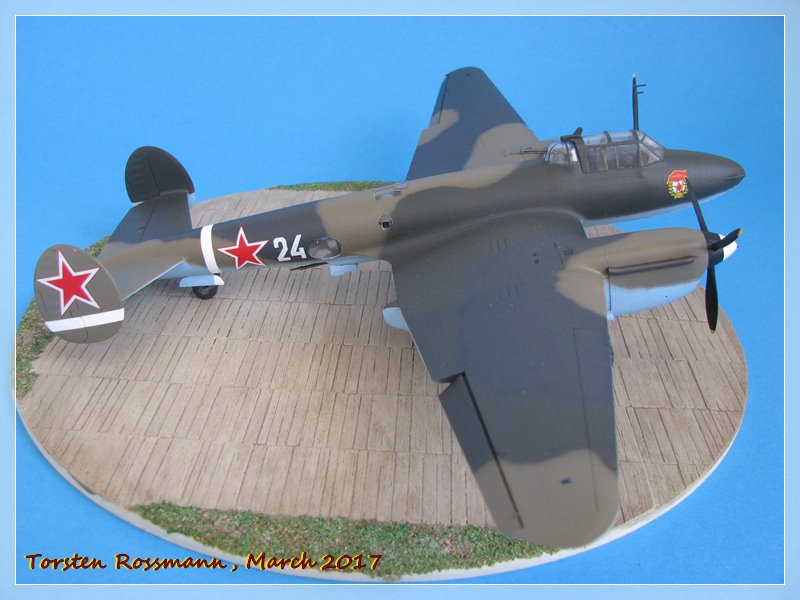
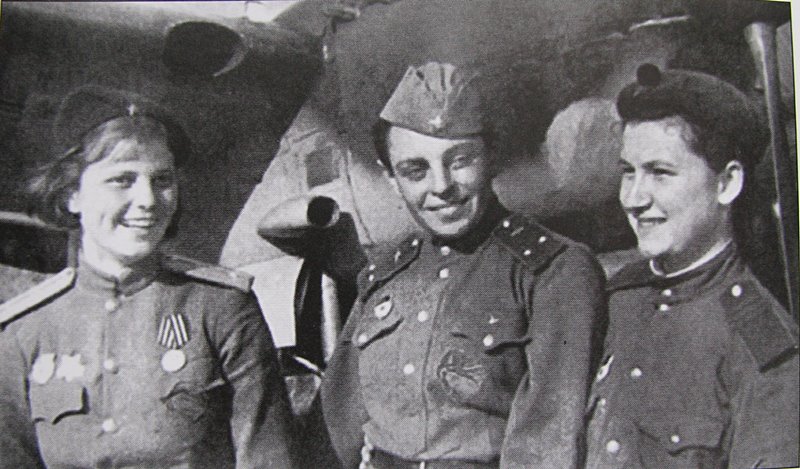
... I have built "White 24" of the 125. GvBAP (Gvardveyskiy Bombardirovochniy Aviapolk = Guards Bomber Air Regiment) at the Balbasovo air field, summer 1944. The CO was Major Valentin Markov. All posts of his subordinates and air crews were women. One of these aviators was Leitenant (Lieutenant) Irina Osadze (center), here with her navigator Lyudmila Popova (left) and radio operator Taisiya Panferova. She took part in the Operation "Bagration". Although the "Peshka" was not easy to fly, she was known as a courageously and good pilot. She was shot down and had to crash land her aircraft a few times but could always avoid captivity. During one crash she was wounded in the face by broken canopy glass. Luck stayed with her and she survived the war. After the war she left the VVS but stayed with her passion and flew civil aircraft for a few more years. My picture source is Ospey Publishing ....
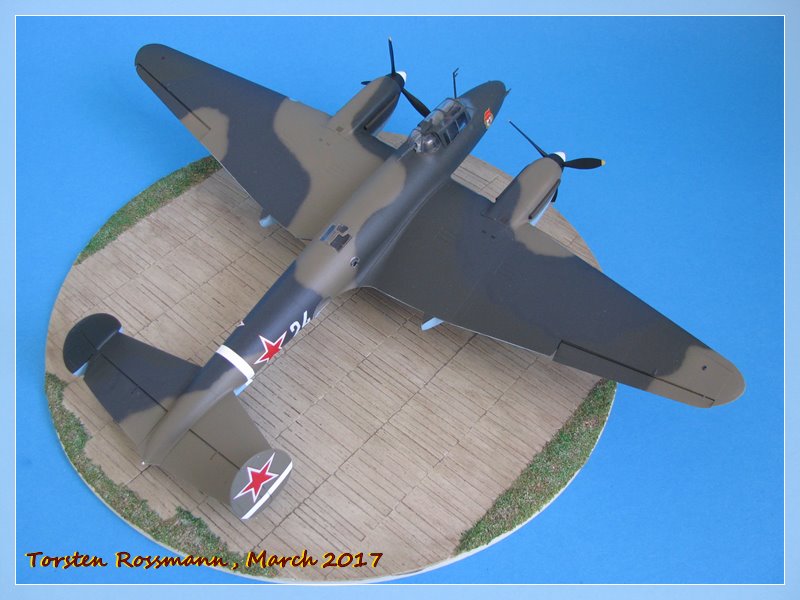
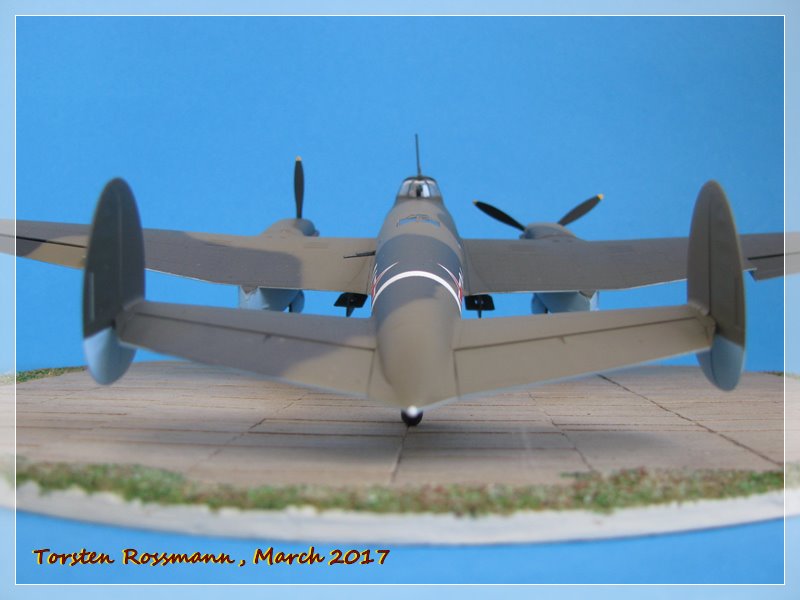
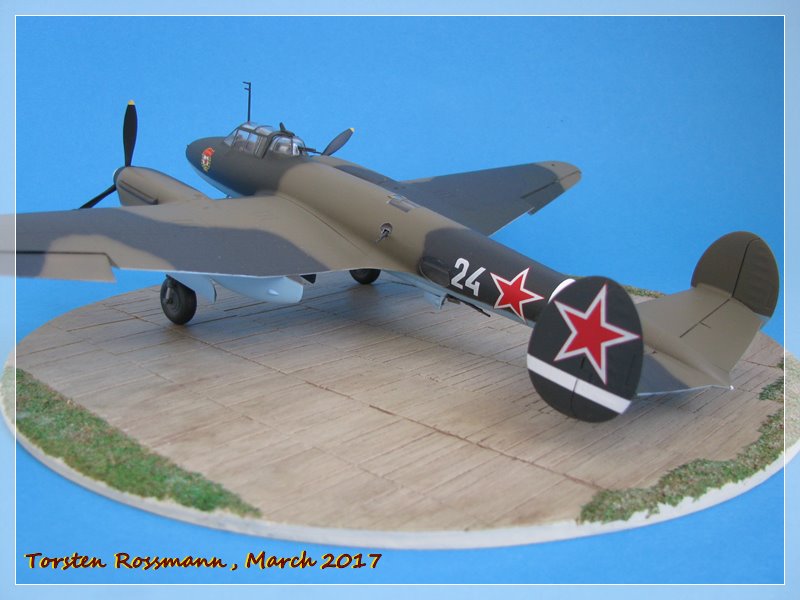
.... this kit took me quite some time (7 weeks) to build. It's very detailed and consists of 435 parts. 50 parts alone for the left engine, which I have also build but not installed because I like the look of the Pe-2 better this way. And it was easier to paint The over all fitting is very good, Zvezda did a great job here. I had only some problems on the underside behind the bomb bay where I had to use some filler. Also the fitting of the big underside window is not perfect, but that might be more my mistake than Zvezda's fault. Everything else goes together easily. The constuction of this kit is well thought out, so sturdy braces hold the wings perfectly so there is no sanding or filler necessary. Painting this bird took me a few days but it was not difficult. For the underside I have used Russian Light Blue R31 from Agama, the upside camouflage is sprayed free hand as usual and I used Russian Green 71281, Russian Tan 71283 and Dark Grey 71054 (all Vallejo paints) for it. The interior was painted with Grey 374 (cockpit and fuselage) and Dark Grey 378 (wheel wells) from Revell. The use of Eduard's mask EX488 is recommended because of all the small clear parts, especially the fuselage turret ....
The over all fitting is very good, Zvezda did a great job here. I had only some problems on the underside behind the bomb bay where I had to use some filler. Also the fitting of the big underside window is not perfect, but that might be more my mistake than Zvezda's fault. Everything else goes together easily. The constuction of this kit is well thought out, so sturdy braces hold the wings perfectly so there is no sanding or filler necessary. Painting this bird took me a few days but it was not difficult. For the underside I have used Russian Light Blue R31 from Agama, the upside camouflage is sprayed free hand as usual and I used Russian Green 71281, Russian Tan 71283 and Dark Grey 71054 (all Vallejo paints) for it. The interior was painted with Grey 374 (cockpit and fuselage) and Dark Grey 378 (wheel wells) from Revell. The use of Eduard's mask EX488 is recommended because of all the small clear parts, especially the fuselage turret ....
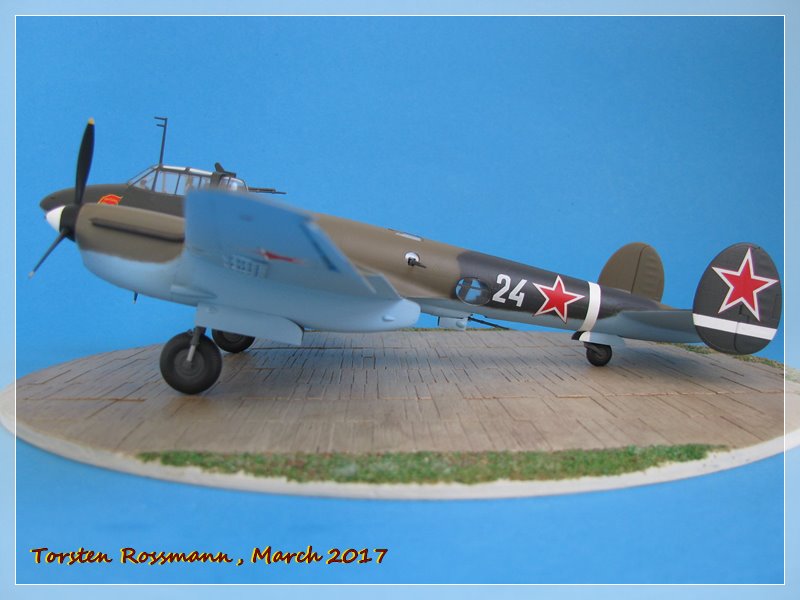
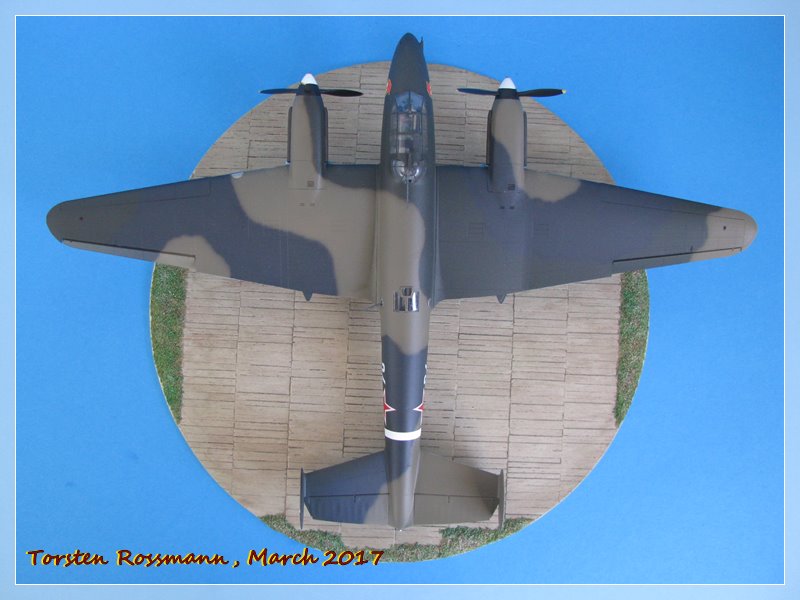

.... Zvezda offers 3 different decal versions for this kit of the 12., 40. and 34. GvBAP, but after reading the story of the 125. I knew what I wanted to build. There are not many decals on the sheet, I have used only 10 on this bird. The white stripes (identification for Operation "Bagration") were easily painted, the only decal which didn't come from the sheet is the "White 24" which was sponsored by a left over of my Il-2 Sturmovik. This kit is really nice to build, it just takes a bit more time because of the big amount of parts. Though many of them vanish in the fuselage and are never seen again. I can recommend this kit without any doubt. Over here I paid only 29 Euros at my LHS for it.
So I say "спасибо" for walking around this beautiful aircraft with me and hope you have enjoyed it.
Happy modelling!
Torsten




.... the Pe-2 was the most numerous soviet twin-engined bomber of WW2. Vladimir Petlyakov designed it as a high altitude fighter under the designation VI-100 when he was imprisoned from 1937 on. The first prototype flew in December 1939. Just as mass production was ready to begin, the VVS ordered a re-design of the aircraft to a tactical bomber. Within 45 days Petlyakov redesigned the aircraft and the result was so good that Stalin ordered to set Petlyakov free again. From that time the aircraft was called Pe-2. Though the flying characteristics were great once the Pe-2 was in the air, the aircraft demanded high flying skills of the pilot during take off and especially during landing because of the high landing speed. The bomber could also not fly on one engine without loosing altitude. Nevertheless more than 10.500 (some sources say 11.500) Pe-2 had been built when production ended in August 1945. The "Peshka", as it was called by its crews, was used as a medium bomber, dive bomer, for ground attack and reconnaissance. It equipped more than 80 bomber regiments. The aircraft with a crew of 3 had a maximum speed of 580 km/h, a range of about 1200 kilometers and a service ceiling of 8800 meters. It was powered by 2 liquid cooled Klimov M-105 engines with 1210 hp each. The armament consited of 2 in the nose fixed ShKAS machine guns and 3 rearward firing machine guns caliber 7,62 mm. It could carry up to 1600 kg of bombs. During the war Finland used 7 captured Pe-2. Post war users were Bulgaria, China, Czechoslovakia, Hungary, Poland and Yugoslavia. There are a few "Peshkas" left in museums around Europe ....



... I have built "White 24" of the 125. GvBAP (Gvardveyskiy Bombardirovochniy Aviapolk = Guards Bomber Air Regiment) at the Balbasovo air field, summer 1944. The CO was Major Valentin Markov. All posts of his subordinates and air crews were women. One of these aviators was Leitenant (Lieutenant) Irina Osadze (center), here with her navigator Lyudmila Popova (left) and radio operator Taisiya Panferova. She took part in the Operation "Bagration". Although the "Peshka" was not easy to fly, she was known as a courageously and good pilot. She was shot down and had to crash land her aircraft a few times but could always avoid captivity. During one crash she was wounded in the face by broken canopy glass. Luck stayed with her and she survived the war. After the war she left the VVS but stayed with her passion and flew civil aircraft for a few more years. My picture source is Ospey Publishing ....



.... this kit took me quite some time (7 weeks) to build. It's very detailed and consists of 435 parts. 50 parts alone for the left engine, which I have also build but not installed because I like the look of the Pe-2 better this way. And it was easier to paint
 The over all fitting is very good, Zvezda did a great job here. I had only some problems on the underside behind the bomb bay where I had to use some filler. Also the fitting of the big underside window is not perfect, but that might be more my mistake than Zvezda's fault. Everything else goes together easily. The constuction of this kit is well thought out, so sturdy braces hold the wings perfectly so there is no sanding or filler necessary. Painting this bird took me a few days but it was not difficult. For the underside I have used Russian Light Blue R31 from Agama, the upside camouflage is sprayed free hand as usual and I used Russian Green 71281, Russian Tan 71283 and Dark Grey 71054 (all Vallejo paints) for it. The interior was painted with Grey 374 (cockpit and fuselage) and Dark Grey 378 (wheel wells) from Revell. The use of Eduard's mask EX488 is recommended because of all the small clear parts, especially the fuselage turret ....
The over all fitting is very good, Zvezda did a great job here. I had only some problems on the underside behind the bomb bay where I had to use some filler. Also the fitting of the big underside window is not perfect, but that might be more my mistake than Zvezda's fault. Everything else goes together easily. The constuction of this kit is well thought out, so sturdy braces hold the wings perfectly so there is no sanding or filler necessary. Painting this bird took me a few days but it was not difficult. For the underside I have used Russian Light Blue R31 from Agama, the upside camouflage is sprayed free hand as usual and I used Russian Green 71281, Russian Tan 71283 and Dark Grey 71054 (all Vallejo paints) for it. The interior was painted with Grey 374 (cockpit and fuselage) and Dark Grey 378 (wheel wells) from Revell. The use of Eduard's mask EX488 is recommended because of all the small clear parts, especially the fuselage turret ....


.... Zvezda offers 3 different decal versions for this kit of the 12., 40. and 34. GvBAP, but after reading the story of the 125. I knew what I wanted to build. There are not many decals on the sheet, I have used only 10 on this bird. The white stripes (identification for Operation "Bagration") were easily painted, the only decal which didn't come from the sheet is the "White 24" which was sponsored by a left over of my Il-2 Sturmovik. This kit is really nice to build, it just takes a bit more time because of the big amount of parts. Though many of them vanish in the fuselage and are never seen again. I can recommend this kit without any doubt. Over here I paid only 29 Euros at my LHS for it.
So I say "спасибо" for walking around this beautiful aircraft with me and hope you have enjoyed it.
Happy modelling!
Torsten


magnusf

Joined: May 02, 2006
KitMaker: 1,953 posts
AeroScale: 1,902 posts

Posted: Saturday, March 11, 2017 - 10:49 PM UTC
Torsten! That's a beautiful aircraft and being flown almost pre-war, it certainly looks ahead of it's time!
Check you in-box for colour suggestions for a more modern subject!

Magnus
Check you in-box for colour suggestions for a more modern subject!

Magnus
thegirl

Joined: January 19, 2008
KitMaker: 6,743 posts
AeroScale: 6,151 posts

Posted: Sunday, March 12, 2017 - 03:55 AM UTC
Well done 
Terri

Terri

BlackWidow

Joined: August 09, 2009
KitMaker: 1,732 posts
AeroScale: 1,336 posts

Posted: Monday, March 13, 2017 - 01:44 AM UTC
Magnus, Terri, thanks for your feedback! Glad you like my "Red Star" twin engine 
Magnus, you're right. The Luftwaffe tested a captured Pe-2 in Rechlin and found out that it was equal to the Ju 88 (to which is was comparable in use) and in some points even superior. This Pe-2 later found its way into the inventory of the Suomen Ilmavoimat ....
Oh, and you have also got something in your mailbox ....
Torsten

Magnus, you're right. The Luftwaffe tested a captured Pe-2 in Rechlin and found out that it was equal to the Ju 88 (to which is was comparable in use) and in some points even superior. This Pe-2 later found its way into the inventory of the Suomen Ilmavoimat ....
Oh, and you have also got something in your mailbox ....

Torsten

BigZimmo

Joined: December 06, 2016
KitMaker: 132 posts
AeroScale: 117 posts

Posted: Friday, March 17, 2017 - 05:58 PM UTC
Another cracker from your assembly line, Torsten. The Pe-2 is really great......well done, mate!! 
Looking forward to see you and your new "worbench products" in Stetten next weekend.
Horrido......
Zimmo

Looking forward to see you and your new "worbench products" in Stetten next weekend.
Horrido......
Zimmo

Posted: Saturday, March 18, 2017 - 03:42 AM UTC
Stefan,
Great finish! A great, clean build.
Gaz
Great finish! A great, clean build.
Gaz

BlackWidow

Joined: August 09, 2009
KitMaker: 1,732 posts
AeroScale: 1,336 posts

Posted: Saturday, March 18, 2017 - 03:47 PM UTC
Thanks for your comment, Gary. Glad you like it, but I won't give Stefan any credit on this build because it's all mine .... 

Stefan, thanks for your feedback, too. Yes, I'm really proud how the Peshka came out finally after long weeks just working on the (now more or less invisible) interior. Of course, Irina will fly to the Stetten Expo next weekend as most of the other stuff I've built since last summer. Including some military vehicles with the Iron Cross on it. So if you hear some roaring, that are just my Leos ....
Torsten


Stefan, thanks for your feedback, too. Yes, I'm really proud how the Peshka came out finally after long weeks just working on the (now more or less invisible) interior. Of course, Irina will fly to the Stetten Expo next weekend as most of the other stuff I've built since last summer. Including some military vehicles with the Iron Cross on it. So if you hear some roaring, that are just my Leos ....

Torsten

Posted: Sunday, March 19, 2017 - 01:08 PM UTC
Torsten,
My apologies!
My apologies!
phumbles

Joined: June 14, 2013
KitMaker: 82 posts
AeroScale: 81 posts
Posted: Sunday, March 19, 2017 - 02:24 PM UTC
Hi Torsten , always a pleasure to see your latest model.cheers Phil. 


BlackWidow

Joined: August 09, 2009
KitMaker: 1,732 posts
AeroScale: 1,336 posts

Posted: Monday, March 20, 2017 - 01:52 AM UTC
Gary, no problem at all!
Phil, thanks for your kind words. I'm glad you enjoy looking at my models (me too .... ) My current model will be more modern than the Peshka and will have "Tre Kronor" as national insignia. So you should visit my jet collection then. Will be finished in April.
) My current model will be more modern than the Peshka and will have "Tre Kronor" as national insignia. So you should visit my jet collection then. Will be finished in April.
Torsten
Phil, thanks for your kind words. I'm glad you enjoy looking at my models (me too ....
 ) My current model will be more modern than the Peshka and will have "Tre Kronor" as national insignia. So you should visit my jet collection then. Will be finished in April.
) My current model will be more modern than the Peshka and will have "Tre Kronor" as national insignia. So you should visit my jet collection then. Will be finished in April.Torsten


BlackWidow

Joined: August 09, 2009
KitMaker: 1,732 posts
AeroScale: 1,336 posts

Posted: Saturday, June 17, 2017 - 01:18 AM UTC
Finished earlier this month I finally have time to show you the newest member of my aviation museum, the Dornier Do 215 B-5 Nightfighter from Revell (ex ICM) in 1/48 .... 
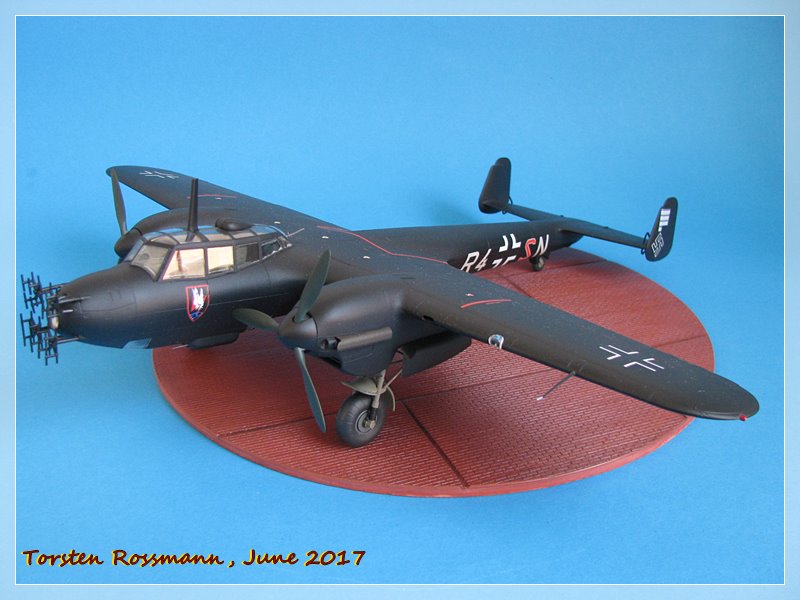
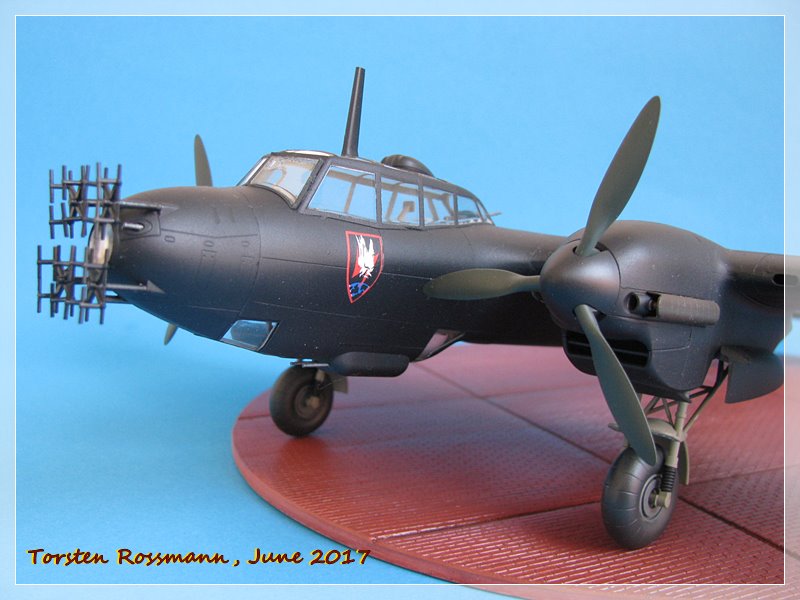
.... the Do 215 was planned as the export version of the Do 17 as Yugoslavia was interested to buy and build it under licence. The prototype was powered by 2 BMW Bramo engines but the flight characteristics were no good enough for the yugoslavian commission, so the plane was not ordered. Dornier decided to change the engines with Daimler Benz DB 601, which showed a noticeable improvement to earlier prototypes. In late 1939 Sweden ordered 18 Do 215 but due to an export embargo of the german government the order was cancelled and the Luftwaffe took over the planes. The Do 215 was a very versatile aircraft used as a bomber, nightfighter, intruder and for reconnaissance. It had a crew of 3 (pilot, navigator, gunner) and was powered by 2 DB 601 engines with 1175 hp each. The maximum speed was 485 km/h in 4000 meters. The usual armament were 4 x MG 15 (7,92 mm). The B-5 nightfighter version had a "Kauz III" called nose equipped with IR searchlight for the Spanner infrared detection system. It was also armed with a 20 mm MG FF plus additional 2 x MG FF in a container under the fuselage. There were only 12 B-5 nightfighters converted from the B-4 version and all used by the NJG 2, based in the Netherlands. Another wartime user of the Do 215 was Hungary ....



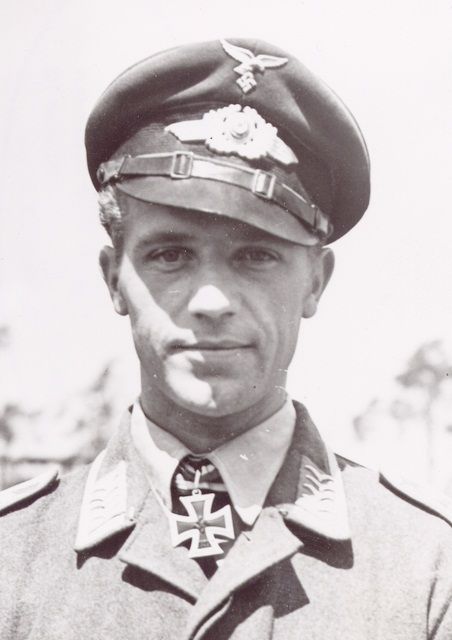
.... I have built R4 + SN from the 5./NJG 2, based at Giltze-Rijen in the Netherlands in 1941/42. This aircraft was flown by Oberfeldwebel (Sergeant, later 1Lt.) Paul Gildner. He was born in 1914 and entered the Wehrmacht in 1933. In 1937 he changed to the Luftwaffe to become a pilot. WW 2 began for him as a member of ZG 1 and pilot on a Bf 110 during the Poland Campaign. During the air battles over France he achieved 4 kills. After the campaign in the west he was trained to become a nightfighter pilot. His first night victory (a Handley Page Hampden) he achieved on the 3. September 1940. On the 9. July 1941 he was awarded the Knights Cross. During 1942 he continuously added kills to his tally which made him one of the most successfull nightfighter pilots of the first half of WW 2. In the early morning hours of the 25. February 1943 when returning from a mission he died in a crash shortly before arriving at Giltze-Rijen with a Bf 110 G-4. The crash was caused by a burning engine. In total Paul Gildner achieved 44 night- and 4 day kills. He is buried today on the german war cemetery in Ysselsteyn/Netherlands ....

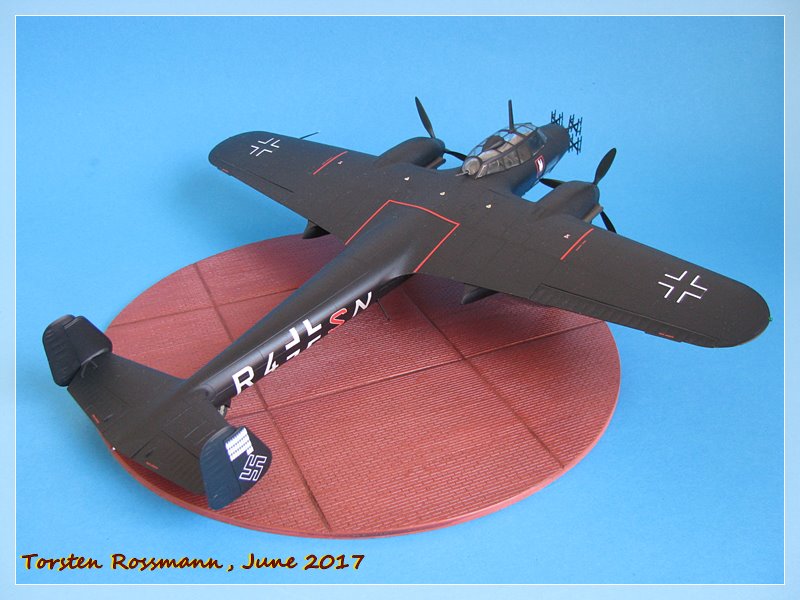
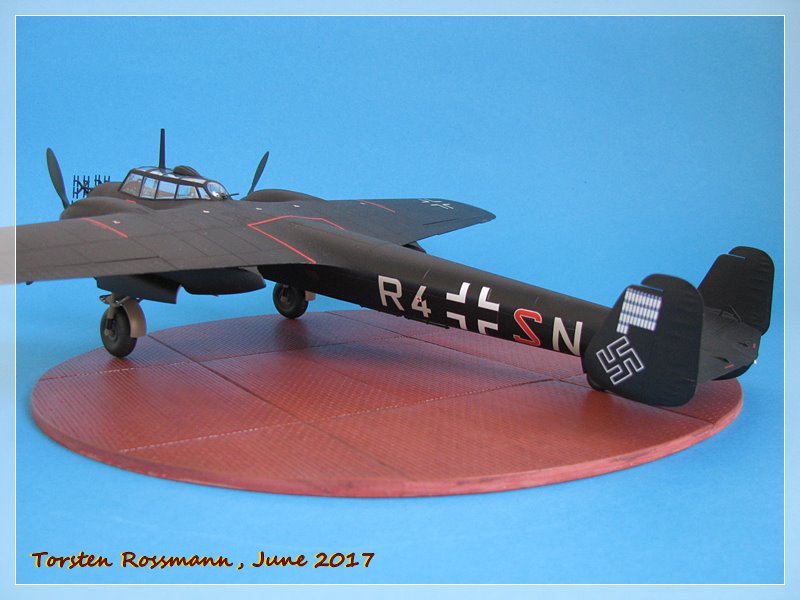
.... building this kit is a bit tricky. Though it's nicely detailed, especially in the cockpit, I came across some annoying fitting issues. So the nightfighter nose doesn't fit well to the fuselage without major surgery on it. I had to erase the "fitting ring" completely and did a lot of test fitting before I glued the nose to the fuselage. There is not much space left to use filler because of the clear parts on the underside of the fuselage. So it was just carefull sanding I could do. Another problem zone is the wings/fuselage area. Just behind the canopy occures a gap which could compete against WW 1 trenches. Here I used clear tape and my self mixed filler (glue and flour). After a lot of sanding I was satisfied with the result. A step shows up at the rear end where the wings meet the fuselage. No filler here but again carefull sanding not to loose the details. It's still visible but that's acceptable for me. The same problem is on the underside. More gaps and steps which I had to battle against the best I could. Because I have closed the engines I had to fight another problem with the top covers. On both was a small hole on the rear end which looks to me like a mould fault. Some more filler and sanding here. So you see, this kit is not an add-glue-and-shake-kit. Adding the dipole antennas was also not so easy. Over night I leaned my Do front upside against the wall. It looked like a big black bug ....

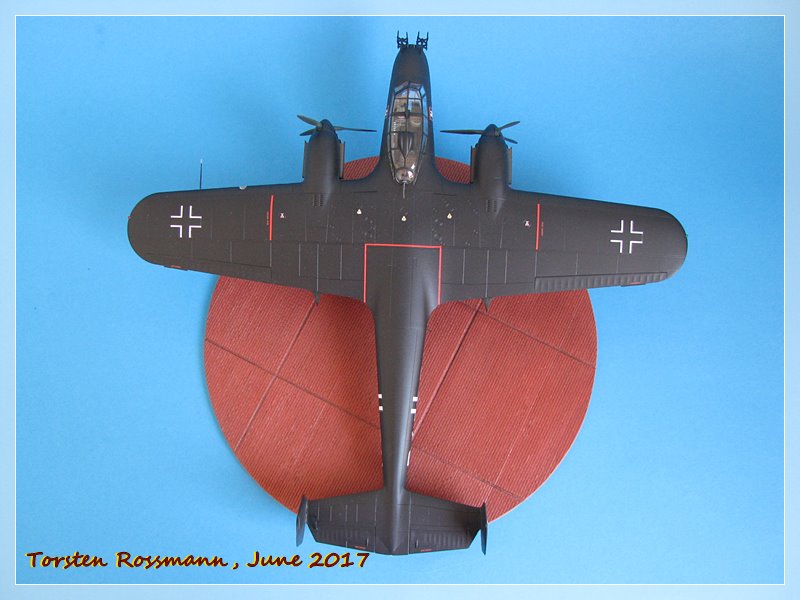

.... painting this bird was quite easy as I used just Black 302 from Revell for it. The interior was mainly painted with Light Olive 45 from Revell, which comes close to RLM 02. That was all. Final coating was made again with Marabu Matt Varnish. The decals are taken from the kit and they are of bad quality. They are stiff and brittle when in warm water. So one of the red lines on the wings broke to several pieces but more important I had to do some emergency rescue to one of the NJG 2 coat of arms because it also broke into several pieces. I don't know what was the intension of Revell to use this decal brand and I will write them an email and tell them about my "experiences". The decals are not from Cartograph, they are made by a company in Portugal. Maybe they are 1 €uro cheaper, who knows. I would recommend, if you want to build this aircraft, look for some better aftermarket decals. I can also recommend to use the Eduard mask EX 485 for the canopy, as it makes work easier. Now that everything is done after a lot of work (and some loud and clear words ....) I must admit that I'm really satisfied with my work and in the end my Do 215 has turned out to a "Black Beauty". And it has already been on 2 expos where I've got a positive feedback ....
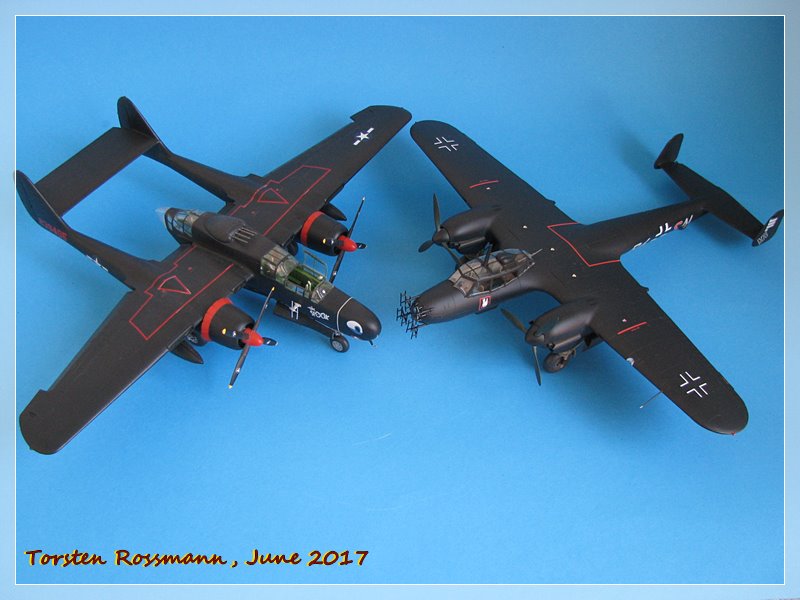
.... finally my other "Black Beauty" was curious to see the new arrival. So this is kind of family photo. It's my favourite P-61 "The Spook" with one of the most striking nose arts I know. You can see it also in my avatar. It's that old Monogram kit from 1974, which I've built about 10 years ago. Some time before I joined Aeroscale.
So, again I say "Vielen Dank" for walking around with me and hope, you have enjoyed the trip.
Happy modelling!
Torsten



.... the Do 215 was planned as the export version of the Do 17 as Yugoslavia was interested to buy and build it under licence. The prototype was powered by 2 BMW Bramo engines but the flight characteristics were no good enough for the yugoslavian commission, so the plane was not ordered. Dornier decided to change the engines with Daimler Benz DB 601, which showed a noticeable improvement to earlier prototypes. In late 1939 Sweden ordered 18 Do 215 but due to an export embargo of the german government the order was cancelled and the Luftwaffe took over the planes. The Do 215 was a very versatile aircraft used as a bomber, nightfighter, intruder and for reconnaissance. It had a crew of 3 (pilot, navigator, gunner) and was powered by 2 DB 601 engines with 1175 hp each. The maximum speed was 485 km/h in 4000 meters. The usual armament were 4 x MG 15 (7,92 mm). The B-5 nightfighter version had a "Kauz III" called nose equipped with IR searchlight for the Spanner infrared detection system. It was also armed with a 20 mm MG FF plus additional 2 x MG FF in a container under the fuselage. There were only 12 B-5 nightfighters converted from the B-4 version and all used by the NJG 2, based in the Netherlands. Another wartime user of the Do 215 was Hungary ....




.... I have built R4 + SN from the 5./NJG 2, based at Giltze-Rijen in the Netherlands in 1941/42. This aircraft was flown by Oberfeldwebel (Sergeant, later 1Lt.) Paul Gildner. He was born in 1914 and entered the Wehrmacht in 1933. In 1937 he changed to the Luftwaffe to become a pilot. WW 2 began for him as a member of ZG 1 and pilot on a Bf 110 during the Poland Campaign. During the air battles over France he achieved 4 kills. After the campaign in the west he was trained to become a nightfighter pilot. His first night victory (a Handley Page Hampden) he achieved on the 3. September 1940. On the 9. July 1941 he was awarded the Knights Cross. During 1942 he continuously added kills to his tally which made him one of the most successfull nightfighter pilots of the first half of WW 2. In the early morning hours of the 25. February 1943 when returning from a mission he died in a crash shortly before arriving at Giltze-Rijen with a Bf 110 G-4. The crash was caused by a burning engine. In total Paul Gildner achieved 44 night- and 4 day kills. He is buried today on the german war cemetery in Ysselsteyn/Netherlands ....



.... building this kit is a bit tricky. Though it's nicely detailed, especially in the cockpit, I came across some annoying fitting issues. So the nightfighter nose doesn't fit well to the fuselage without major surgery on it. I had to erase the "fitting ring" completely and did a lot of test fitting before I glued the nose to the fuselage. There is not much space left to use filler because of the clear parts on the underside of the fuselage. So it was just carefull sanding I could do. Another problem zone is the wings/fuselage area. Just behind the canopy occures a gap which could compete against WW 1 trenches. Here I used clear tape and my self mixed filler (glue and flour). After a lot of sanding I was satisfied with the result. A step shows up at the rear end where the wings meet the fuselage. No filler here but again carefull sanding not to loose the details. It's still visible but that's acceptable for me. The same problem is on the underside. More gaps and steps which I had to battle against the best I could. Because I have closed the engines I had to fight another problem with the top covers. On both was a small hole on the rear end which looks to me like a mould fault. Some more filler and sanding here. So you see, this kit is not an add-glue-and-shake-kit. Adding the dipole antennas was also not so easy. Over night I leaned my Do front upside against the wall. It looked like a big black bug ....



.... painting this bird was quite easy as I used just Black 302 from Revell for it. The interior was mainly painted with Light Olive 45 from Revell, which comes close to RLM 02. That was all. Final coating was made again with Marabu Matt Varnish. The decals are taken from the kit and they are of bad quality. They are stiff and brittle when in warm water. So one of the red lines on the wings broke to several pieces but more important I had to do some emergency rescue to one of the NJG 2 coat of arms because it also broke into several pieces. I don't know what was the intension of Revell to use this decal brand and I will write them an email and tell them about my "experiences". The decals are not from Cartograph, they are made by a company in Portugal. Maybe they are 1 €uro cheaper, who knows. I would recommend, if you want to build this aircraft, look for some better aftermarket decals. I can also recommend to use the Eduard mask EX 485 for the canopy, as it makes work easier. Now that everything is done after a lot of work (and some loud and clear words ....) I must admit that I'm really satisfied with my work and in the end my Do 215 has turned out to a "Black Beauty". And it has already been on 2 expos where I've got a positive feedback ....

.... finally my other "Black Beauty" was curious to see the new arrival. So this is kind of family photo. It's my favourite P-61 "The Spook" with one of the most striking nose arts I know. You can see it also in my avatar. It's that old Monogram kit from 1974, which I've built about 10 years ago. Some time before I joined Aeroscale.
So, again I say "Vielen Dank" for walking around with me and hope, you have enjoyed the trip.
Happy modelling!
Torsten

Posted: Saturday, June 17, 2017 - 01:21 AM UTC
Very handsome beast!
I like the two night fighters side by side, interesting to compare the two.
I like the two night fighters side by side, interesting to compare the two.


BlackWidow

Joined: August 09, 2009
KitMaker: 1,732 posts
AeroScale: 1,336 posts

Posted: Monday, June 19, 2017 - 12:29 AM UTC
Thanks for your comment, Jonathan! It was a lot of work but in the end my patience with it paid off.
Both birds had a crew of 3 but the P-61 is still slightly bigger, had stonger engines and a more powerful armament than the Do 215. Though the model isn't small at all with a length of 35 cm and a wing span of 37 cm. I plan to add 2 more all-black aircraft to my "Black Squadron" sooner or later. That will be the new Night Defiant from Airfix (sooner) and the Night Beaufighter from Tamiya (later). If you go back to page 6 you'll see that I've already built a Night Beau but not in black.
Torsten
Both birds had a crew of 3 but the P-61 is still slightly bigger, had stonger engines and a more powerful armament than the Do 215. Though the model isn't small at all with a length of 35 cm and a wing span of 37 cm. I plan to add 2 more all-black aircraft to my "Black Squadron" sooner or later. That will be the new Night Defiant from Airfix (sooner) and the Night Beaufighter from Tamiya (later). If you go back to page 6 you'll see that I've already built a Night Beau but not in black.
Torsten


BlackWidow

Joined: August 09, 2009
KitMaker: 1,732 posts
AeroScale: 1,336 posts

Posted: Wednesday, September 20, 2017 - 12:16 AM UTC
After returning from another great vacation in beautiful Latvia (I love it!) in early August I stared with a "stormy" duett and today I would like to show you Part 1 of it. It's the Hawker Hurricane Mk. I from Airfix, as usual in 1/48 .... 
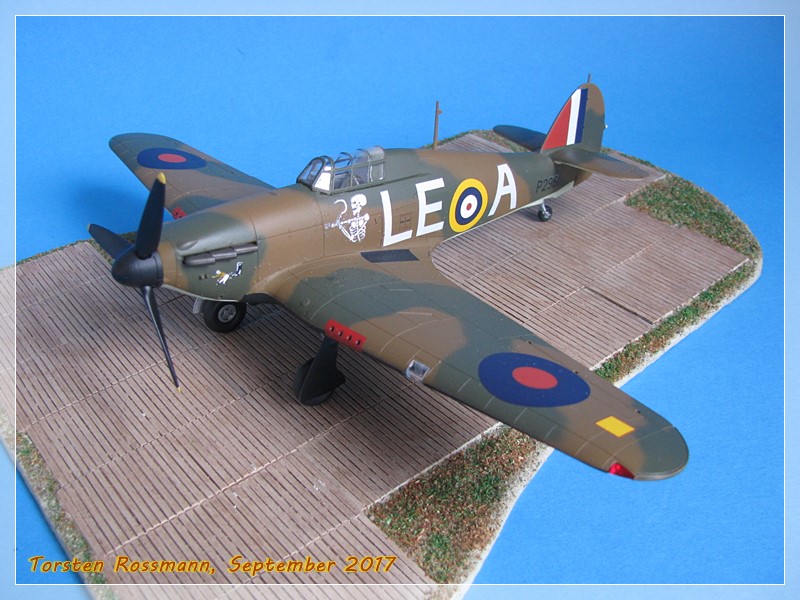

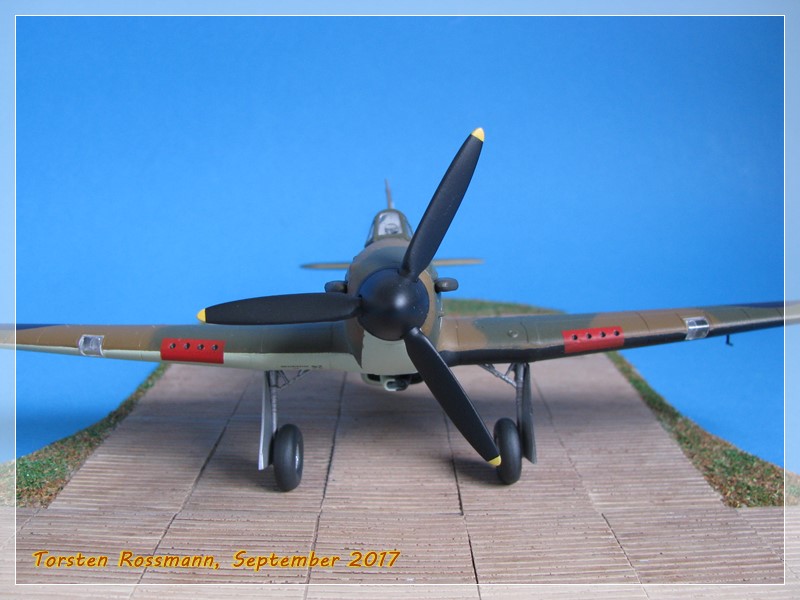
.... the Hurricane is surely one of the iconic planes of WW 2. First flight was on the 6. November 1935 and production lasted from 1936 to 1944. During the first years of the war the Hurricane was the backbone of the RAF Fighter Command. It's finest hour it had during the Battle of Britain though it always stood a bit in the shadow of the Spitfire. The Mk. I was powered by a Rolls Royce Merlin III with 1030 hp. It had a maximum speed of 510 km/h and a range of about 750 kilometers. The armament were 8 Browning machine guns in the wings, caliber 7,7 mm (0,303 inch) with 330 rounds each. More than 14.500 "Hurris" of all versions were built and used in more than a dozen countries ....
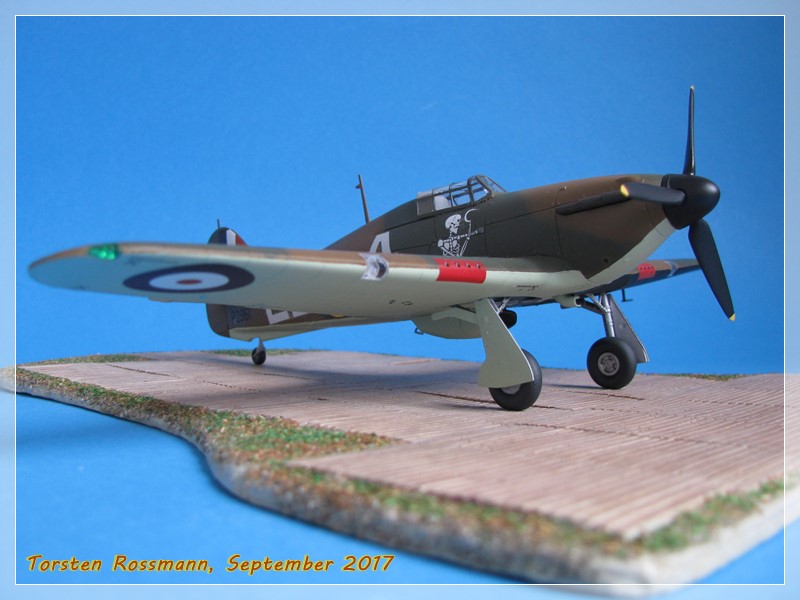
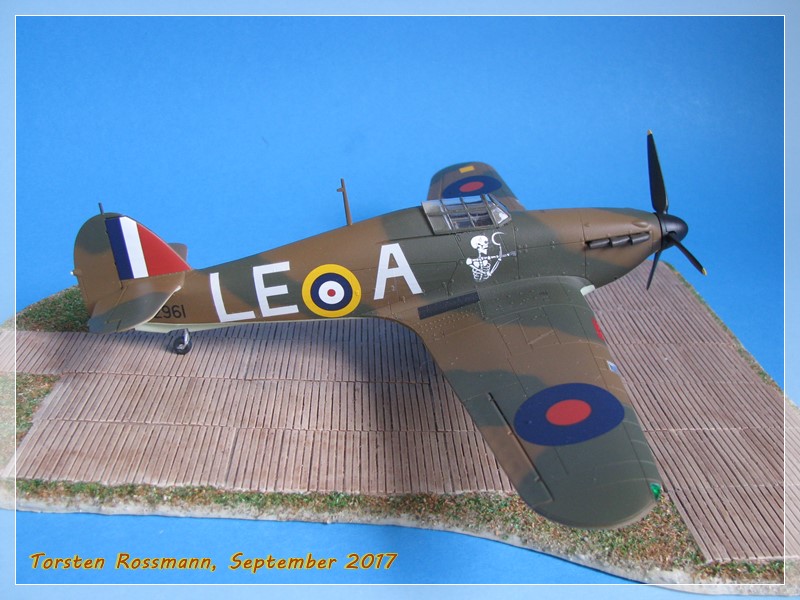
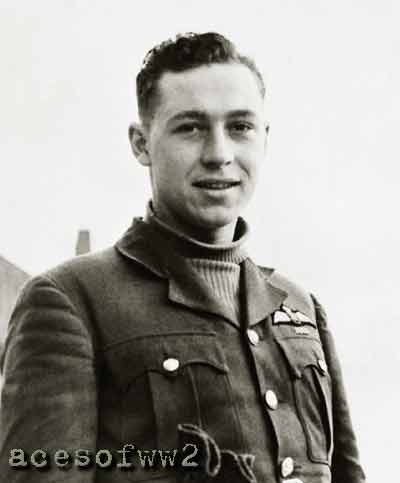
.... I have built LE o A of No. 242 Sqn based at Martlesham Heath in January 1941. This aircraft was the mount of F/O William Lidstone McKnight. He was born in Edmonton/Canada in 1918 and volunteered for the Royal Air Force in 1939. After training to become a fighter pilot he was posted to No. 242 Sqn and took part in the defense of France as part of the BEF. His first victory he claimed on the 19. May 1940 near Cambrai. During the evacuation of Dunkirk he shot down 6 german aircraft in 4 days. His unit suffered heavy losses (11 pilots dead or missed) and was posted back to England, where McKnight became the wingman of famous SqnLdr Douglas Bader. From July 1940 the unit was also involved in the Battle of Britain where McKnight scored further kills. On the 30. August 1940 he was awarded the Distinguished Flying Cross which was given to him 3 days later by King George VI. On the 12. January 1941 McKnight attacked german E-Boats in the Channel together with P/O M. Brown when they were "surprised" by a Bf 109. While Brown was able to escape home, McKnight failed to return. He was never found and has no known grave. With 17 kills he is one of the most successful canadian fighter pilots. Calgary's McKnight Boulevard is named after him ....

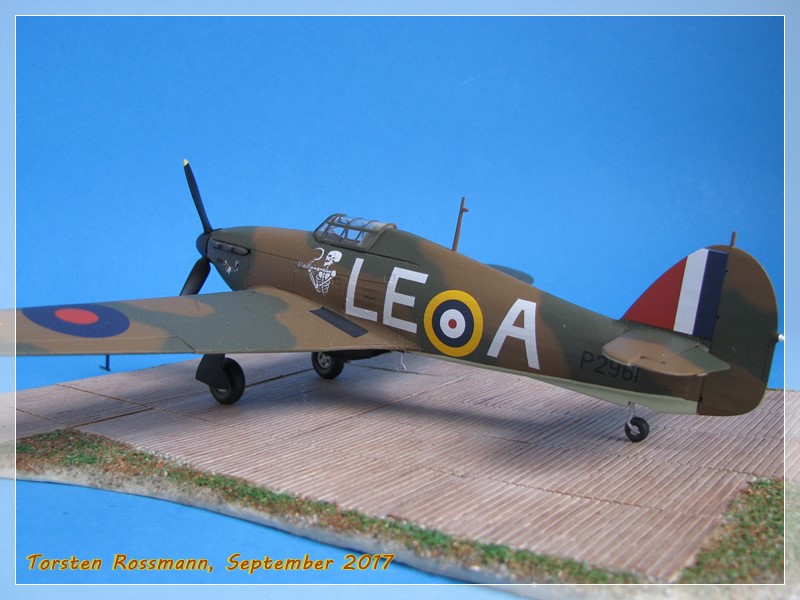

.... building this kit is quite easy. It's one of Airfix' new kits and the fitting is very good. I can't remember any major problems, no filler was used, just the usual sanding here and there. Though some of the 127 parts are not used for this version. There are options to build the Hurricane with open cockpit, closed landing gear or open gun bays. I decided not to do that because the parts have to be cut our out of the wings, which doesn't look easy. And you know me by now, I don't like too many open hatches ....
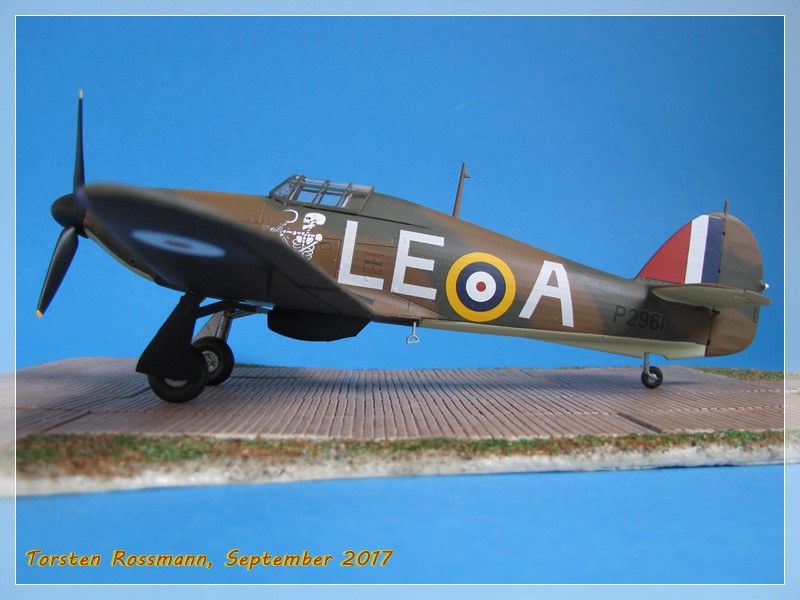
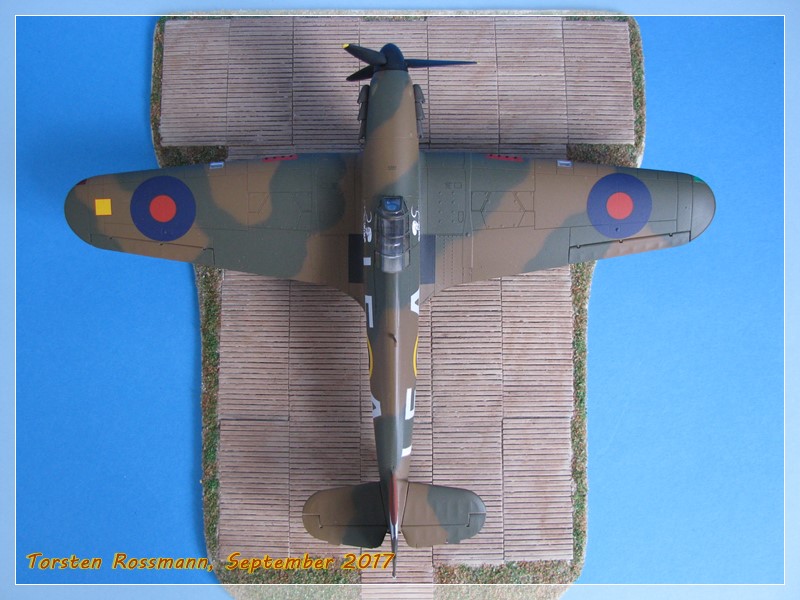

.... I have again used various paint brands on this kit. After a layer of white primer I have used Sky 59 and Black 302 from Revell Aqua on the underside. For the upperside I used Dark Earth 82 from Revell and Dark Green 71016 from Vallejo. Dark Green is airbrushed free hand. Interior and wheel wells are painted with Aluminium 99 also from Revell. Of course this models is build oob and not weathered as usual. Stencils and national insignia come from the kit's decal sheet while the special decals to build McKnight's machine are taken from Sky Models "Hawker Hurricane Pt.1" (No. 48051). It's a fantastic sheet for no less than 15 Hurricanes of various versions. It's of great quality printed by Cartograf. I bought this sheet several years ago at the expo in Basel and it's not the only Sky Models sheet I have.
So I thank you again for walking around my new "Hurri" with me and hope you have enjoyed it. Part 2 of my duett will follow soon. And it has no RAF roundels ....
Happy modelling!
Torsten




.... the Hurricane is surely one of the iconic planes of WW 2. First flight was on the 6. November 1935 and production lasted from 1936 to 1944. During the first years of the war the Hurricane was the backbone of the RAF Fighter Command. It's finest hour it had during the Battle of Britain though it always stood a bit in the shadow of the Spitfire. The Mk. I was powered by a Rolls Royce Merlin III with 1030 hp. It had a maximum speed of 510 km/h and a range of about 750 kilometers. The armament were 8 Browning machine guns in the wings, caliber 7,7 mm (0,303 inch) with 330 rounds each. More than 14.500 "Hurris" of all versions were built and used in more than a dozen countries ....



.... I have built LE o A of No. 242 Sqn based at Martlesham Heath in January 1941. This aircraft was the mount of F/O William Lidstone McKnight. He was born in Edmonton/Canada in 1918 and volunteered for the Royal Air Force in 1939. After training to become a fighter pilot he was posted to No. 242 Sqn and took part in the defense of France as part of the BEF. His first victory he claimed on the 19. May 1940 near Cambrai. During the evacuation of Dunkirk he shot down 6 german aircraft in 4 days. His unit suffered heavy losses (11 pilots dead or missed) and was posted back to England, where McKnight became the wingman of famous SqnLdr Douglas Bader. From July 1940 the unit was also involved in the Battle of Britain where McKnight scored further kills. On the 30. August 1940 he was awarded the Distinguished Flying Cross which was given to him 3 days later by King George VI. On the 12. January 1941 McKnight attacked german E-Boats in the Channel together with P/O M. Brown when they were "surprised" by a Bf 109. While Brown was able to escape home, McKnight failed to return. He was never found and has no known grave. With 17 kills he is one of the most successful canadian fighter pilots. Calgary's McKnight Boulevard is named after him ....



.... building this kit is quite easy. It's one of Airfix' new kits and the fitting is very good. I can't remember any major problems, no filler was used, just the usual sanding here and there. Though some of the 127 parts are not used for this version. There are options to build the Hurricane with open cockpit, closed landing gear or open gun bays. I decided not to do that because the parts have to be cut our out of the wings, which doesn't look easy. And you know me by now, I don't like too many open hatches ....




.... I have again used various paint brands on this kit. After a layer of white primer I have used Sky 59 and Black 302 from Revell Aqua on the underside. For the upperside I used Dark Earth 82 from Revell and Dark Green 71016 from Vallejo. Dark Green is airbrushed free hand. Interior and wheel wells are painted with Aluminium 99 also from Revell. Of course this models is build oob and not weathered as usual. Stencils and national insignia come from the kit's decal sheet while the special decals to build McKnight's machine are taken from Sky Models "Hawker Hurricane Pt.1" (No. 48051). It's a fantastic sheet for no less than 15 Hurricanes of various versions. It's of great quality printed by Cartograf. I bought this sheet several years ago at the expo in Basel and it's not the only Sky Models sheet I have.
So I thank you again for walking around my new "Hurri" with me and hope you have enjoyed it. Part 2 of my duett will follow soon. And it has no RAF roundels ....
Happy modelling!
Torsten

raypalmer

Joined: March 29, 2010
KitMaker: 1,151 posts
AeroScale: 985 posts

Posted: Wednesday, September 20, 2017 - 03:16 AM UTC
You're one of the tidiest modellers out there. We all know that so often weatherization etc are as much tricks of convenience or necessity as tools for a good model. Making a clean, factory fresh type model like you do is very difficult. I really like your builds/appreciate that kind of neatness.

Scrodes

Joined: July 22, 2012
KitMaker: 771 posts
AeroScale: 763 posts

Posted: Thursday, September 21, 2017 - 05:25 AM UTC
Torsten - your PE-2 has both ailerons deflected down... 

Posted: Thursday, September 21, 2017 - 10:53 AM UTC
Torsten,
I haven't seen this thread in quite some time. Your Dornier 215 looks excellent. I have been trying to will myself into making some aerials for a couple of 1/72 night fighters I have laying around.
Your Hurricane looks great, too.
But you know me...I love Luftwaffe birds.
Gaz
I haven't seen this thread in quite some time. Your Dornier 215 looks excellent. I have been trying to will myself into making some aerials for a couple of 1/72 night fighters I have laying around.
Your Hurricane looks great, too.
But you know me...I love Luftwaffe birds.
Gaz

magnusf

Joined: May 02, 2006
KitMaker: 1,953 posts
AeroScale: 1,902 posts

Posted: Thursday, September 21, 2017 - 11:03 AM UTC
I'm with Gary on this one: lovely Hurricane! And I really like those new Airfix kits even if I stick to 1/72. They really have found a level that works concerning both quality of fit, detail and price!

Magnus

Magnus

BlackWidow

Joined: August 09, 2009
KitMaker: 1,732 posts
AeroScale: 1,336 posts

Posted: Thursday, September 21, 2017 - 11:25 PM UTC
Wow, thanks for your feedback, guys!
Richard, thanks for your kind words. I'm glad you like what you see. I prefer to do no weathering on my models and leave it all to the dust on my shelf instead of ruining them with doing too much of it. I'm also often attending expos, so I have to clean them a bit every time.
Matt, yes I know, but I won't change it now.
Gaz, thanks for your comment. After all the work I've had with the Do 215 I'm really satisfied with the result. The patience paid off. It's no "add glue and shake" kit. So if you want to build it, take your time for it. At the moment I have no plans for another Luftwaffe aircraft. My next build will be a Ventura for the ANZAC Campaign.
Magnus, also thanks to you! In the meantime I have build some new Airfix kits (Spitfire, Defiant, Hurricane ...) and am also pleased about the quality for a good price. I believe it's the same in 1/72. Hope they can stay that way.
Happy modelling!
Torsten
Btw, my other Hurricane just left the assembly line. Hope the photographer has time this weekend ....
Richard, thanks for your kind words. I'm glad you like what you see. I prefer to do no weathering on my models and leave it all to the dust on my shelf instead of ruining them with doing too much of it. I'm also often attending expos, so I have to clean them a bit every time.
Matt, yes I know, but I won't change it now.
Gaz, thanks for your comment. After all the work I've had with the Do 215 I'm really satisfied with the result. The patience paid off. It's no "add glue and shake" kit. So if you want to build it, take your time for it. At the moment I have no plans for another Luftwaffe aircraft. My next build will be a Ventura for the ANZAC Campaign.
Magnus, also thanks to you! In the meantime I have build some new Airfix kits (Spitfire, Defiant, Hurricane ...) and am also pleased about the quality for a good price. I believe it's the same in 1/72. Hope they can stay that way.
Happy modelling!
Torsten

Btw, my other Hurricane just left the assembly line. Hope the photographer has time this weekend ....
BigZimmo

Joined: December 06, 2016
KitMaker: 132 posts
AeroScale: 117 posts

Posted: Friday, September 22, 2017 - 03:16 AM UTC
Hi Torsten!
Your Hurri is another cracking model from your workbench.
And as Richard said, to build a model, fresh from the factory, requires a great care in assembling.
With aging etc. you can still conceal some.....just as I do!!! ;-) Therefore, thumbs up for your tidy models.
I am looking forward to the coming weekend in Augsburg to meet you and the other guys again.
Horrido....
Stefan
Your Hurri is another cracking model from your workbench.
And as Richard said, to build a model, fresh from the factory, requires a great care in assembling.
With aging etc. you can still conceal some.....just as I do!!! ;-) Therefore, thumbs up for your tidy models.
I am looking forward to the coming weekend in Augsburg to meet you and the other guys again.
Horrido....
Stefan


greif8

Joined: January 17, 2006
KitMaker: 673 posts
AeroScale: 492 posts

Posted: Sunday, September 24, 2017 - 11:42 AM UTC
Hallo Torsten, sehr schöne flugzüge! I really like the Hurricane and Do215. Like you I often pick a particular plane that has an interesting story connected to its pilot or crew. I like the nice clean look of your builds, and your standard of workmanship is very high indeed. I live in Bayern, so maybe we will see each other at one of the expos in the future.
Sincerely,
Ernest
Sincerely,
Ernest

BlackWidow

Joined: August 09, 2009
KitMaker: 1,732 posts
AeroScale: 1,336 posts

Posted: Sunday, September 24, 2017 - 08:51 PM UTC
Quoted Text
.... With aging etc. you can still conceal some.....
Horrido....
Stefan
flaws is the word you're looking for, Stefan!

Thanks for your comment, my friend. But don't think my models are flawless. None is that. There are more than I like to. In Augsburg I can show you some. Oh yes, I'm also looking forward to meet you and the rest of the bunch next weekend.
Ernest, thanks for your words! I'm glad you like what you see. I always try to give my models a "face". So whenever I have the name of a pilot I try to find out something about him, the best with a photo which I can post here. So I do a lot of reseach in that direction. Sometimes it's easy to find informations like about McKnight and Gildner. But sometimes it's really difficult like in the case of Masao Itagaki. A really hard nut to crack was Irina Osadze. I had only the photo from Osprey and her name and unit. The research was every now and then over several months. There were only small hints to her when I suddenly stumbled over her name. And this is all that I found out. But it's better than nothing.
If you want to meet me and have a look at my models you have the chance this coming weekend when I attend the expo of PMV Augsburg in Augsburg-Haunstetten. I'll be there Saturday and Sunday.
Torsten


BlackWidow

Joined: August 09, 2009
KitMaker: 1,732 posts
AeroScale: 1,336 posts

Posted: Tuesday, October 03, 2017 - 12:27 AM UTC
Finished last week I finally have time to show you the other part of my dual build. Here is my Hawker Hurricane Mk. IIb, converted from a IIc. The kit is from Revell (ex Hasegawa) ....

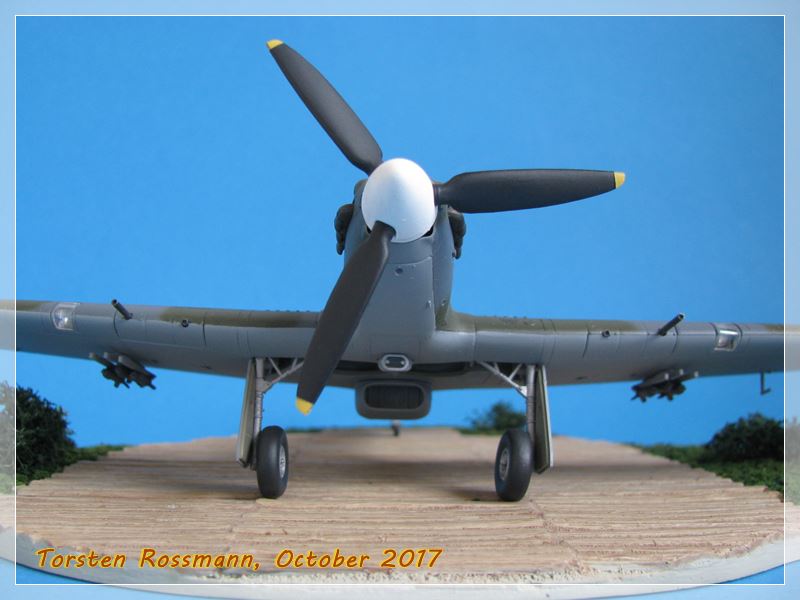
.... by the end of 1941 the Red Army Air Force was almost annihilated and the Soviet Union found itself desperately short of fighter aircraft. In an effort to rectify this situation, the british government supplied the first of over 3300 Hurricanes from late 1941 and handed them over to the SU under a lend-lease agreement. The Hurricanes were quickly thrown into action and virtually all of them were issued to fighter regiments in the northern sector of the front. The Hurricane proved to be an easy aircraft to master. They provided air cover for the vital Murmansk - Belomorsk section of the Kirov railway. Their pilots fought bloody dogfights with the Bf 109 pilots of the Jagdgeschwader 5 and the Finnish Air Force. The Hurricanes remained in frontline service until late 1943 ....
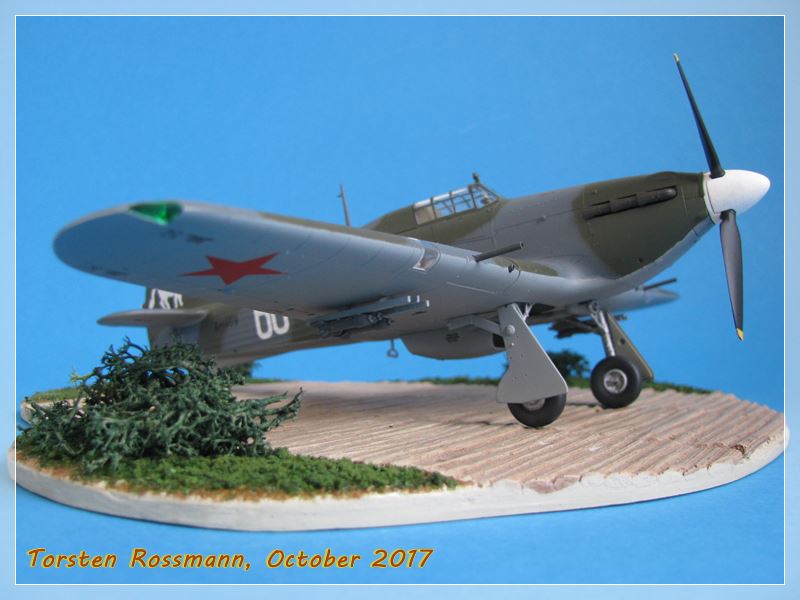
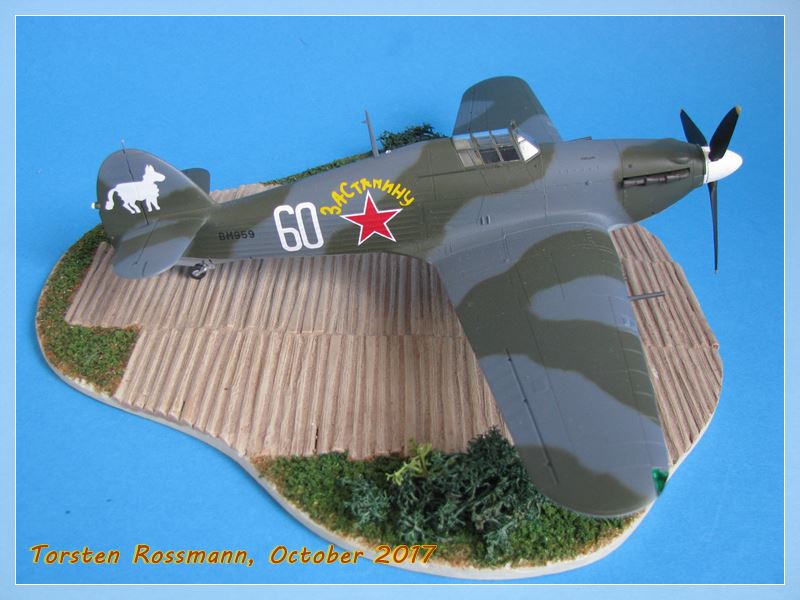

.... I have built "White 60" of the 609. IAP which was shot down by finnish AA fire near the airfield of Tiiksjärvi in Karelia on the 6. April 1942. The pilot Lt. Ivan Babanin had to crash land the Hurricane nearby and was captured by finnish soldiers ....



.... Revell Germany came out with the kit of a Mk. IIc in 2002 but as I had this nice set of decals I needed to do some surgery to get the desired Mk. IIb. Last year I asked here on Aeroscale about the main visible differences of the two versions, which are the weapons, and the conversion was not difficult. Russian Hurricanes were often rearmed with a 20 mm ShVAK cannon and a 12,7 mm UB machine gun in each wing. There is an unused part for the wing guns in the kit and I just drilled 2 holes in it and used Evergreen tubes for the guns. Further I drilled holes in the underwing section and took rockets and rails from a Trumpeter MiG 3 kit. While this conversion was an easy work, getting the rest of the kit together was more difficult than I thought, though the Hasegawa kit is not known for giving much trouble. Especially in the wing/fuselage area I had big problems with a difference in height between the wings and their counterpart on the fuselage and gaps which had to be filled and sanded. I think I did not too bad with the effort to make it look nice. But most other parts go together well ....

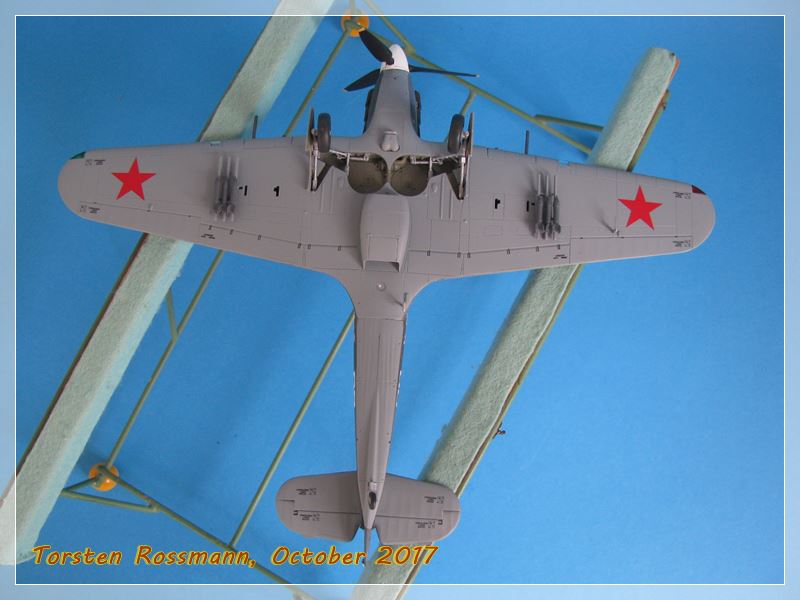
.... on this bird I used the Vallejo paints for the camouflage. On the underside it's Medium Sea Grey 71307, the upperside is painted with Ocean Grey 71273 first and then Dark Green 71016 sprayed again freehand over it. For the interior I used Light Grey-Green 45 from Revell Aqua. I have used only very few stencils on the underside of the kit's decal sheet, though I guess the Russians had no stencils in english on their Hurris. The special decals to build "White 60" are taken from the same Skymodels decal sheet as on the Hurricane from above. Though Skymodels made a big mistake here. The slogan above the fuselage red star is "For the Fatherland" on the left side, while it says "For Stalin" on the right side. Skymodels printed the same slogan for both sides .... They just should have had a look into Osprey's "Soviet Lend-Lease Aces" (No. 74) to notice their mistake. Anyway, in the absence of a correct substitute, I have used the decals. I can't read russian and I won't tell anyone about this fault ....
They just should have had a look into Osprey's "Soviet Lend-Lease Aces" (No. 74) to notice their mistake. Anyway, in the absence of a correct substitute, I have used the decals. I can't read russian and I won't tell anyone about this fault .... 
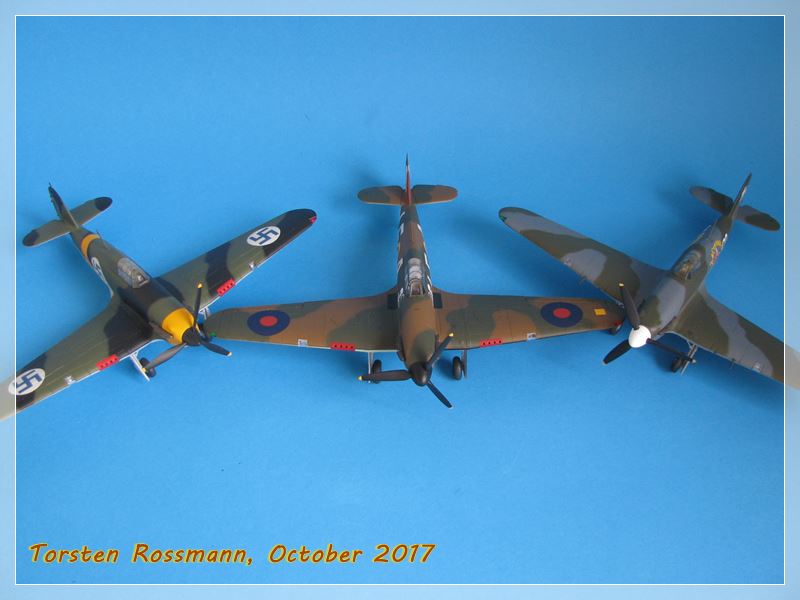
.... finally the obligatory family photo. The FiAF Hurricane is a Mk. I and an orginal Hasegawa kit which I bought several years ago at the FiAF Museum in Tikkakoski. That build didn't give me troubles as far as I remember. It was not seldom that over Karelia a Hurricane had a dogfight with another Hurricane. One with a blue Hakaristi on the fuselage and the other with a Red Star ....
So again I say "Большое спасибо" for walking around my newest Hurri and hope you have enjoyed it.
Happy modelling!
Torsten


.... by the end of 1941 the Red Army Air Force was almost annihilated and the Soviet Union found itself desperately short of fighter aircraft. In an effort to rectify this situation, the british government supplied the first of over 3300 Hurricanes from late 1941 and handed them over to the SU under a lend-lease agreement. The Hurricanes were quickly thrown into action and virtually all of them were issued to fighter regiments in the northern sector of the front. The Hurricane proved to be an easy aircraft to master. They provided air cover for the vital Murmansk - Belomorsk section of the Kirov railway. Their pilots fought bloody dogfights with the Bf 109 pilots of the Jagdgeschwader 5 and the Finnish Air Force. The Hurricanes remained in frontline service until late 1943 ....



.... I have built "White 60" of the 609. IAP which was shot down by finnish AA fire near the airfield of Tiiksjärvi in Karelia on the 6. April 1942. The pilot Lt. Ivan Babanin had to crash land the Hurricane nearby and was captured by finnish soldiers ....



.... Revell Germany came out with the kit of a Mk. IIc in 2002 but as I had this nice set of decals I needed to do some surgery to get the desired Mk. IIb. Last year I asked here on Aeroscale about the main visible differences of the two versions, which are the weapons, and the conversion was not difficult. Russian Hurricanes were often rearmed with a 20 mm ShVAK cannon and a 12,7 mm UB machine gun in each wing. There is an unused part for the wing guns in the kit and I just drilled 2 holes in it and used Evergreen tubes for the guns. Further I drilled holes in the underwing section and took rockets and rails from a Trumpeter MiG 3 kit. While this conversion was an easy work, getting the rest of the kit together was more difficult than I thought, though the Hasegawa kit is not known for giving much trouble. Especially in the wing/fuselage area I had big problems with a difference in height between the wings and their counterpart on the fuselage and gaps which had to be filled and sanded. I think I did not too bad with the effort to make it look nice. But most other parts go together well ....


.... on this bird I used the Vallejo paints for the camouflage. On the underside it's Medium Sea Grey 71307, the upperside is painted with Ocean Grey 71273 first and then Dark Green 71016 sprayed again freehand over it. For the interior I used Light Grey-Green 45 from Revell Aqua. I have used only very few stencils on the underside of the kit's decal sheet, though I guess the Russians had no stencils in english on their Hurris. The special decals to build "White 60" are taken from the same Skymodels decal sheet as on the Hurricane from above. Though Skymodels made a big mistake here. The slogan above the fuselage red star is "For the Fatherland" on the left side, while it says "For Stalin" on the right side. Skymodels printed the same slogan for both sides ....
 They just should have had a look into Osprey's "Soviet Lend-Lease Aces" (No. 74) to notice their mistake. Anyway, in the absence of a correct substitute, I have used the decals. I can't read russian and I won't tell anyone about this fault ....
They just should have had a look into Osprey's "Soviet Lend-Lease Aces" (No. 74) to notice their mistake. Anyway, in the absence of a correct substitute, I have used the decals. I can't read russian and I won't tell anyone about this fault .... 

.... finally the obligatory family photo. The FiAF Hurricane is a Mk. I and an orginal Hasegawa kit which I bought several years ago at the FiAF Museum in Tikkakoski. That build didn't give me troubles as far as I remember. It was not seldom that over Karelia a Hurricane had a dogfight with another Hurricane. One with a blue Hakaristi on the fuselage and the other with a Red Star ....
So again I say "Большое спасибо" for walking around my newest Hurri and hope you have enjoyed it.
Happy modelling!
Torsten

 |




